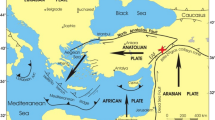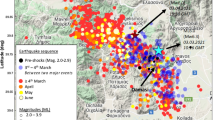Abstract
On January 24, 2020, an 6.8 magnitude (Mw) earthquake struck the Sivrice district of Elazığ province in south-eastern Türkiye. The earthquake, which occurred in the East Anatolian Fault Zone (EAFZ), affected many structures. In particular, most of the masonry buildings close to the epicenter were severely damaged or destroyed and the earthquake resulted in 41 fatalities. This paper aims to provide information on the tectonic characteristics of the EAFZ, the seismic characteristics of the earthquake territory and the general characteristics of the main shock. Another purpose of this paper is to reveal the damage caused by the earthquake to the masonry buildings in rural areas through post-earthquake field observations. As a result of the field observations, the types of damage seen in masonry structures are poor workmanship and binder damages, in/out of the plane mechanism, damages due to the absence of lintels or insufficient lintel length, weak load‑bearing walls damage, corner damages and multi-leaf walls damages. The most important reason for the damage to the structures is the lack of engineering services and not being constructed in accordance with earthquake codes. In addition, considering the damage to the masonry buildings as a result of the field studies, some retrofitting methods are presented for strengthening existing masonry buildings with low seismic performance against future earthquakes.

(Adopted from Marroni et al. 2020)

(Adopted from Şaroğlu et al. 1992)



















(Adopted from Appleton 2009)

(Adopted from Shrestha et al. 2012)

(Adopted from Henriques et al. 2011)


(Adopted from Meireles and Bento 2013)

(Adopted from Meireles and Bento 2013)
Similar content being viewed by others
References
Appleton J (2009) Técnicas de reabilitação de estruturas de alvenaria, Seminar Patologia, Inspecção e Reabilitação de Edificios tradicionais (in Portuguese)
Basaglia A, Aprile A, Spacone E, Pelà F (2020) Assessing community resilience, housing recovery and impact of mitigation strategies at the urban scale: a case study after the 2012 Northern Italy Earthquake. Bull Earthq Eng 18:6039–6074
Bayraktar A, Altunışık AC, Pehlivan M (2013) Performance and damages of reinforced concrete buildings during the October 23 and November 9, 2011 Van, Turkey, earthquakes. Soil Dynam Earthq Eng 53:49–72
Bayraktar A, Altunışık AC, Muvafik M (2014) Damages of minarets during Erciş and Edremit earthquakes, 2011 in Turkey. Smart Struct Syst 14(3):479–499
Bayraktar A, Altunışık AC, Türker T, Karadeniz H, Erdoğdu Ş, Angın Z, Özşahin TŞ (2015) Structural performance evaluation of 90 RC buildings collapsed during October 23 and November 9, 2011 Van, Turkey, earthquakes. J Perform Constr Facilit ASCE 29(6):1–19
Bozkurt E (2001) Neotectonics of Turkey–A synthesis. Geod Acta 14:3–30
Branco M, Guerreiro LM (2011) Seismic rehabilitation of historical masonry buildings. Eng Str 33:1626–1634
Brando G, De Matteis G, Spacone E (2017) Predictive model for the seismic vulnerability assessment of small historic centres: application to the inner Abruzzi Region in Italy. Eng Struct 153:81–96
Calayır Y, Sayın E, Yön B (2012) Performance of structures in the rural area during the March 8, 2010 Elazığ-Kovancılar earthquake. Nat Haz 61(2):703–717
Celep Z, Erken A, Taskin B, Ilki A (2011) Failures of masonry and concrete buildings during the March 8, 2010 Kovancılar and Palu (Elazığ) Earthquakes in Turkey. Eng Fail Anal 18:868–889
Corradi M, Borri A, Poverello E, Castori G (2017) The use of transverse connectors as reinforcement of multi-leaf walls. Mater Struct 50:114
Dedeoğlu İÖ, Yetkin M, Calayır Y (2022) 24 January 2020 Sivrice-Elazığ earthquake: assessment of seismic characteristics of earthquake, earthquake territory and structural performance of reinforced concrete structures. Sakarya Univ J Sci 26(5):1892–1907. https://doi.org/10.16984/saufenbilder.1005024
DEMA (2020a) January 24, 2020 Sivrice (Elazığ) earthquake report. Earth Dep Dis A Emerg Manag Pres, Ankara, Turkey
DEMA (2020b) Earthquake department of the disaster and emergency management presidency. Ankara, Turkey. http://www.afad.gov.tr/
Doğangün A (2004) Performance of reinforced concrete buildings during the May 1, 2003 Bingöl earthquake in Turkey. Eng Str 26:841–856
Günaydın M, Atmaca B, Demir S, Altınışık AC, Hüsem M, Adanur S, Ateş Ş, Angın Z (2021) Seismic damage assessment of masonry buildings in Elazığ and Malatya following the 2020 Elazığ-Sivrice earthquake, Turkey. Bull Earth Eng 19:2421–2456
Henriques DF, Nunes L, de Brito J (2011) Reabilitação Estrutural de Edifícios Antigos—Alvenaria, Madeira—Técnicas pouco intrusivas. Ed. Argumentum & Gecorpa. In CIMAD 11–1º Congresso Ibero-Latino Americano da madeira na construção 279–280, Lisbon, Portugal (in Portuguese)
Hosseini M (2005) Behavior of nonstructural elements in the 2003 Bam, Iran, earthquake. Earthq Spect 21:439–453
Kürçer A, Elmacı H, Yıldırım N, Özalp S (2020) January 24, 2020 Sivrice (Elazığ) Depremi (Mw = 6.8) Field observation and evaluation report. Min Res A Expl Inst, Ankara (in Turkish)
Mahdizadeh A, Borzouie J, Raessi M, (2012) New approach to seismic rehabilitation of masonry school buildings. Proc. 15th W Conf Earth Eng, Lisbon, Portugal 2851, Lisbon, Portugal
Marroni M, Göncüoğlu MC, Frassi C, Sayit K, Pandolf L, Ellero A, Ottria G (2020) The Intra-Pontide ophiolites in Northern Turkey revisited: from birth to death of a Neotethyan oceanic domain. Geosci Front 11(1):129–149
Meireles H Bento R (2013) Rehabilitation and strengthening of old masonry buildings. Report ICIST, DTC, (02)
MTA-Mineral Research and Exploration General Directorate (2020) January 24, 2020 Sivrice (Elazığ) Earthquake Report
Okay AI, Zattin M, Cavazza W (2010) Apatite fission-track data for the Miocene Arabia-Eurasia collision. Geology 38(1):35–38
Ricci P, Luca F, Verderame GM (2011) 6th April 2009 L’Aquila earthquake, Italy: reinforced concrete building performance. Bull Earth Eng 9:285–305
Rossetto T, Peiris N (2009) Observations of damage due to the Kashmir earthquake of October 8, 2005 and study of current seismic provisions for buildings in Pakistan. Bull Earth Eng 7:681–699
Şaroğlu F, Emre Ö, Kuşcu İ (1992) The East Anatolian fault zone of Turkey. Ann Tect 6:99–125
Sayin E, Yon B, Calayir Y, Gor M (2014) Construction failures of masonry and adobe buildings during the 2011 Van earthquakes in Turkey. Struct Eng Mech 51(3):503–518
Sayın E, Yön B, Onat O, Gör M, Öncü ME, Tunç ET, Bakır D, Karaton M, Calayır Y (2021) 24 January 2020 Sivrice-Elazığ, Turkey earthquake: geotechnical evaluation and performance of structures. Bull Earth Eng 19:657–684
Sezen H, Whittaker AS, Elwood KJ, Mosalam KM (2003) Performance of reinforced concrete buildings during the August 17, 1999 Kocaeli, Turkey earthquake, and seismic design and construction practise in Turkey. Eng Str 25:103–114
Sharma K, Deng L, Noguez CC (2016) Field investigation on the performance of building structures during the April 25, 2015, Gorkha earthquake in Nepal. Eng Struct 121:61–74
Shrestha H, Pradhan S, Guragain R (2012) Experiences on retrofitting of low strength masonry buildings by different retrofitting techniques in Nepal. Proc. 15th W Conf Earth Eng, Lisbon, Portugal
Sisti R, Di Ludovico M, Borri A, Prota A (2019) Damage assessment and the effectiveness of prevention: the response of ordinary unreinforced masonry buildings in Norcia during the Central Italy 2016–2017 seismic sequence. Bull Earthq Eng 17:5609–5629
TBEC (2018) Disaster and emergency management presidency, Türkiye Bina Deprem Yönetmeliği (in Turkish)
TEC (1998) Ministry of public works and housing, Afet Bölgelerinde Yapılacak Yapılar Hakkında Yönetmelik (in Turkish)
TEC (2007) Ministry of public works and housing, Deprem Bölgelerinde Yapılacak Binalar Hakkında Esaslar, Disaster and Emergency Management Presidency, (in Turkish)
Valluzzi MR, da Porto F, Modena C (2001) Behaviour of multi-leaf stone masonry walls strengthened by different intervention techniques. Hist Const 1023–1032
Yetkin M, Dedeoğlu İÖ, Calayır Y (2021) Investigation and assessment of damages in the minarets existing at Elazig after 24 January 2020 Sivrice earthquake. Fırat Univ J Eng Sci 33(2):379–389
Acknowledgements
This work was supported by the Scientific Research Projects Coordination Unit of Fırat University (Grant Numbers ADEP.23.13).
Funding
This work was supported by Scientific Research Projects Coordination Unit of Fırat University (Grant Numbers ADEP.23.13).
Author information
Authors and Affiliations
Corresponding author
Ethics declarations
Conflict of interest
The authors declare the following financial interests/personal relationships, which may be considered as potential competing interests: This work was supported by Scientific Research Projects Coordination Unit of Fırat University (Grant Numbers ADEP.23.13).
Ethical Approval
The manuscript was not be submitted to more than one journal for simultaneous consideration. The submitted work is original and has not been published elsewhere in any form or language (partially or in full). A single study was not be split up into several parts to increase the quantity of submissions and submitted to various journals or to one journal over time. Results are presented openly, honestly, and without fabrication, falsification, or inappropriate data manipulation (including image-based manipulation). No data, text or theory of others is presented as the authors' own. Appropriate acknowledgments were given to other studies.
Rights and permissions
Springer Nature or its licensor (e.g. a society or other partner) holds exclusive rights to this article under a publishing agreement with the author(s) or other rightsholder(s); author self-archiving of the accepted manuscript version of this article is solely governed by the terms of such publishing agreement and applicable law.
About this article
Cite this article
Dedeoğlu, İ.Ö., Yetkin, M., Calayır, Y. et al. January 24, 2020 Sivrice-Elazığ (Türkiye) Earthquake: The Seismic Assessment of the Earthquake Territory, Geotechnical Findings and Performance of Masonry Buildings. Iran J Sci Technol Trans Civ Eng 48, 2393–2412 (2024). https://doi.org/10.1007/s40996-023-01318-0
Received:
Accepted:
Published:
Issue Date:
DOI: https://doi.org/10.1007/s40996-023-01318-0




